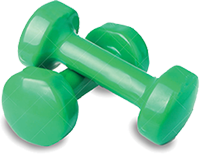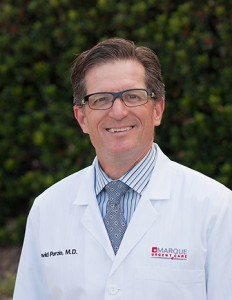Exercise Helps You Live Longer by David G. Porzio, M.D.
A key element to longevity and having the physiologic reserve to deal with illness is regular exercise; both aerobic and some form of resistance training. As the body ages, muscles atrophy. After the age of 40, on average, muscle mass declines by 8% per decade. That means at age 80 you will have lost 32% of your muscle mass since age 40. This loss of strength through muscle atrophy is the primary reason people become weaker with age (duh). Age-related weakness leads to an unsteady gait (walking) poor stamina or endurance and the ability to recover from illness, especially acute severe illnesses like a heart attack, stroke, severe infection or orthopedic injury (think hip fracture). The good news is that you can maintain lean muscle mass throughout your golden years with regular exercise.
In my experience, the reason a younger person (age 40 or less) has a higher survivability from a severe acute illness is the protein reserve found in their lean muscle. When someone experiences a prolonged hospitalization particularly when critically ill, the caloric demands are enormous; 5,000-7,000 calories per day. Since the person is unable to eat normally to keep up with the demand, the body goes into a catabolic state, which means it is essentially eating itself. One of the primary sources of calories is the protein found in muscle. The fact that the person is bedridden and unable to exercise in a meaningful way means that there is no new protein or muscle synthesis (building). The resulting muscle loss can be extreme. By some estimates, 20% of muscle mass is lost during a 60 day hospitalization. Studies have also shown that muscle loss is more significant in the elderly population by 3-6 times their younger counterparts. A younger person with a protein reserve can recover. An 80 or 90 year old person who has very little protein reserve can be left in such a debilitated state that complications are inevitable and they do not survive. The importance of maintaining your lean muscle and cardiovascular fitness is not just relevant to being hospitalized.
Shortness of breath or becoming easily fatigued with activity is as frequent a complaint as I have ever seen. The most common reason people develop these symptoms is not heart or lung disease, It is…care to guess…deconditioning. The heart is a muscle. Sure it has specific properties that make it a unique muscle but it requires regular activity to maintain its fitness as well. When someone reaches 40 they develop cardiovascular deconditioning more rapidly than when they were younger and it takes longer to regain it. Moreover, it is very difficult to ever exceed the level of fitness you had when you were younger. That is why elite athletes peak in their 20s to 30s. It is clearly the exception when a 40 year old plus athlete can be competitive with someone who is 25. That being said, it does not mean someone cannot maintain cardiovascular fitness with lean muscle mass well into their 40s, 50s, 60s, and beyond.
One does not need to pump weights to gain the physical fitness their body requires to be healthy. Resistance training can be performed with free weights and weight machines but many people lack access to this equipment and the knowledge how to perform the exercises properly and safely. One could hire a personal trainer assuming of course they have the disposable income for this expense. In lieu of a gym membership or personal trainer, the next best thing is body weight fitness. This is a form of exercise that uses your own body weight to provide the resistance required to build muscle mass. Think about it, doing push-ups, pull ups, lunges, squats against your own body weight can and does build significant strength and endurance. Herschel Walker, a former professional football player, claimed to have never lifted weights and only did body weight fitness. In his prime he had one of the most chiseled physiques I have seen. A simple Google search for “body weight fitness for the elderly” brings up an abundance of internet sites with all the information you could want to research this very effective way of rebuilding your lean muscle mass and reducing your body fat composition. Improving lean muscle mass should also be complemented with a program to improve cardiovascular conditioning.
Although being able to run 3 miles, 5 miles, 10 miles a marathon is admirable, it is not actually the best way to “train” your heart and develop cardiovascular fitness. Interval training, which is short bursts of intense exercise followed by a brief period of rest is actually more beneficial than running 5 miles at a steady pace. Interval training has been shown to increase levels of nitric oxide, which is a chemical produced by the blood vessels and important for maintaining the elasticity of the arteries among other things. Interval training is very effective at lowering the resting heart rate and increasing the “heart rate reserve” (HRR), which is the difference between the resting heart rate and the maximum heart rate. Think about it, if you start at a baseline HR of 90 and your max is say 160, your HRR = 70. If you’re in good cardiovascular condition, your resting HR may be 60 and the HRR = 100. That is a big difference. Training the heart to perform the same amount of work in 50 bpm as opposed to 90 bpm is key to longevity.
In conclusion, you need to exercise through all phases of life but especially after age 40. Your muscles simply start slowly wasting away and if you do nothing to maintain them it is like spending all the money in your savings account. You will have nothing in reserve when you really need it when an unexpected and severe illness occurs. You don’t need to pump heavy weights and bulk up. You can use your own body weight as the resistance. There are an abundance of websites and information on the worldwide web regarding body weight fitness so just Google it. Remember you must also exercise your heart, which is one of the most important muscles you have. It needs to be trained as well. Interval training is the best way to get it in shape: short bursts of high intensity exercise followed by a rest period and then repeat. 20 minutes is all it takes but at least 4 days per week. Once again an internet search will provide you with more websites than you can possible view regarding interval training regimens. You should always complement your exercise with a healthy diet, avoiding simple sugars and carbohydrates, emphasizing lean protein and vegetables. Make sure to get plenty of rest and allow the body to recover between the workouts. Finally, you may want to consult your physician before embarking on a new exercise routine, especially if you are older and have not been physically active for awhile. Consulting a personal trainer to help you develop a tailored exercise program may be helpful and provide direction. Check with your local city services to see what may be available as well. In Newport Beach there is the Oasis Senior Center, which has a full gym and classes. Undoubtedly there are similar facilities in the cities our Aliso Viejo and Ranch Santa Margarita locations serve. Best of luck as build the new you. Now drop and give me 20!


